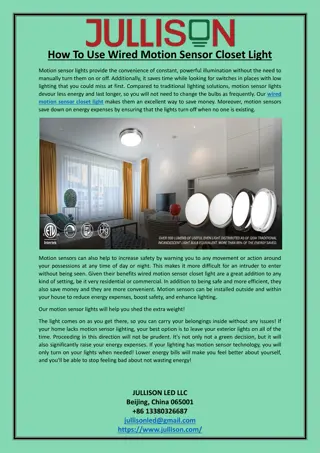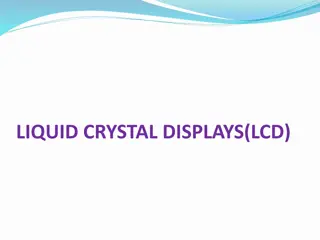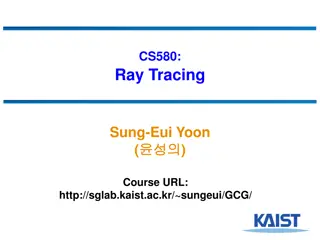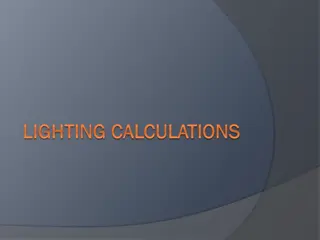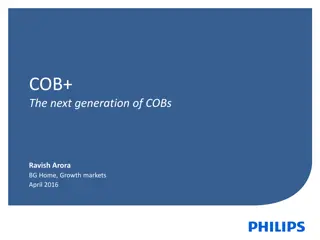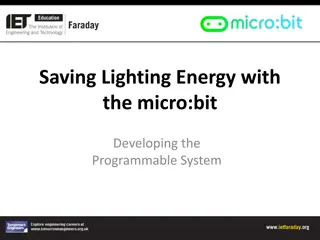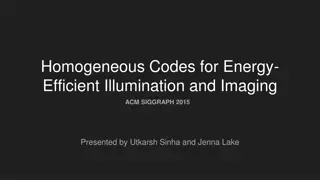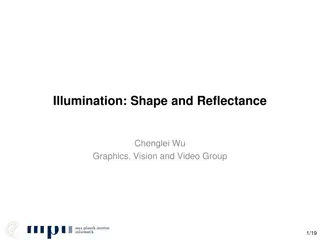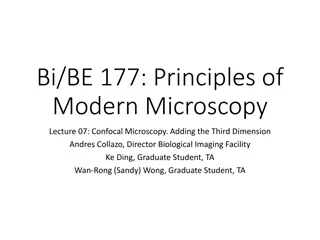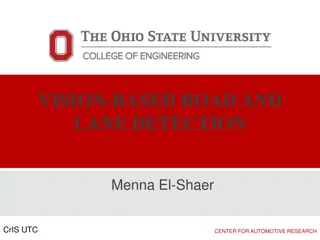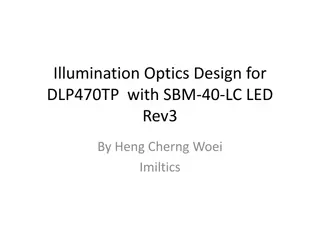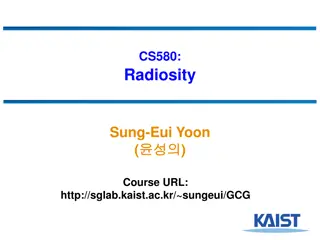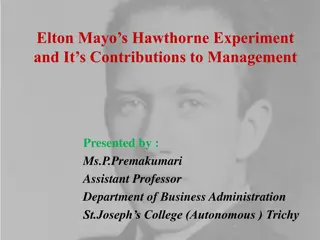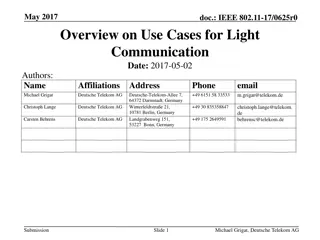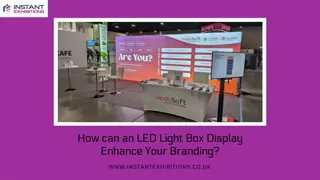How To Use Wired Motion Sensor Closet Light
Motion sensor lights provide the convenience of constant, powerful illumination without the need to manually turn them on or off. Additionally, it saves time while looking for switches in places with low lighting that you could miss at first. Compared to traditional lighting solutions, motion sensor
1 views • 1 slides
Clear Glass Globe Chandeliers A Timeless Elegance for Modern Interiors
Clear glass globe chandeliers have become a popular choice in contemporary interior design, offering a perfect blend of elegance, sophistication, and versatility. These lighting fixtures not only provide ample illumination but also serve as striking
9 views • 2 slides
Proposal for Updated Stop Lamp Illumination Requirements
The proposal suggests updating stop lamp illumination requirements to reflect modern EV capabilities and ensure consistency regardless of propulsion type. It addresses technical constraints and scenarios where stop lamps should illuminate or not based on deceleration sources and intentions. The aim
1 views • 8 slides
Liquid Crystal Displays (LCDs) and Their Advantages
Liquid Crystal Displays (LCDs) offer advantages such as low power consumption, cost-effectiveness, and good contrast. These displays consist of liquid crystal cells sandwiched between glass sheets with transparent electrodes. The LCD relies on external illumination for visibility and uses nematic li
0 views • 14 slides
Enchanting Conclusion of Lil and Pepe's Journey
The last chapter culminates with Lil and Pepe returning Kyky's heart to the tomb shared with Lysandra and Maya, under the magical illumination of sunlight. As they hope for a safe return amidst the lingering danger, questions arise about Tulip's well-being and the characters' fate. Comprehension que
0 views • 10 slides
The Phases of the Moon and the Lunar Cycle
The moon goes through eight distinct phases during its 27-day Lunar Cycle, each characterized by its illumination level as seen from Earth. From the invisible New Moon to the fully illuminated Full Moon, learn about each phase and how they occur as the moon orbits the Earth.
0 views • 15 slides
Advanced Microscopy Techniques in EUV Lithography: SHARP Overview
SHARP utilizes Fresnel zone plate lenses to achieve diffraction-limited quality in EUV lithography, offering a range of NA values and image magnifications. The system allows emulation of mask-side imaging conditions with hundreds of lenses available. Coherence control and engineering are provided th
2 views • 18 slides
Advancements in Technology and Rendering Time Efficiency
As technology progresses, rendering time remains constant in the field of computer graphics. Concepts like local illumination for rough surfaces and abstract light sources, ray-sphere intersection, and structuring of intersectable objects are discussed. The process involves ray tracing and handling
0 views • 19 slides
Ray Tracing Techniques in Computer Graphics
Explore the fundamentals of ray tracing including recursive ray casting, ray casting vs. ray tracing, basic algorithms, shadows, reflections, refractions, and advanced illumination models like Whitted model and OpenGL's illumination model. Learn about casting rays from the eye, handling reflections
0 views • 50 slides
Lighting Calculations for Effective Illumination
Lighting calculations play a crucial role in determining the optimal lighting levels for various spaces. The Lumen Method and Point Calculations help evaluate illumination requirements, while factors like Light Loss Factor and Coefficient of Utilization ensure efficient lighting design. Learn how to
0 views • 13 slides
Next Generation of COBs - Innovative LED Lighting Solutions
Explore the COB+ lighting range by Home BG, featuring high wattage LED spots with superior performance and durability. The COB+ series offers a wide voltage protection range, surge protection, and long-lasting LED technology, delivering bright light with no harmful UV radiation. Check out the Philip
0 views • 9 slides
Developing an Automatic Lighting System with micro:bit
Explore how to save lighting energy with the micro:bit by developing a programmable system for automatic lighting in homes. The project involves using sensors to detect motion, LED lights for illumination, and programming the micro:bit to control the lighting based on occupancy in the room. Get hand
0 views • 8 slides
Face Recognition: A Comprehensive Literature Survey
This literature survey delves into the importance and challenges of face recognition technology, covering topics such as biometrics, human face recognition, variations in pose and illumination, early and modern approaches, as well as the evaluation of face recognition systems. The need for face reco
0 views • 30 slides
Energy-Efficient Illumination and Imaging Techniques for Structured Light Applications
This presentation at ACM SIGGRAPH 2015 by Utkarsh Sinha and Jenna Lake explores the use of homogeneous codes to optimize energy efficiency in structured light applications. The focus is on distinguishing between translucency and inter-reflections, removing artifacts, reconstructing 3D objects in cha
0 views • 34 slides
Spiritual Blindness of the Natural Man in Corinthians
The natural man, devoid of spiritual discernment, finds the things of the Spirit foolish and incomprehensible. Without illumination from the Holy Spirit, they cannot grasp the depths of God's Word. This spiritual blindness leads to the rejection of the message of salvation through Christ, perceived
0 views • 14 slides
Advanced Techniques in Shape and Illumination Analysis
Exploring cutting-edge methods such as shape recovery from varying illumination and viewpoint, dynamic shape refinement from multi-view video, and depth estimation through photometric stereo constraints. The process involves factorization, compute depth maps, normal field calculations, and final sur
0 views • 13 slides
Lighting Design Requirements and Project Guidelines
Detailed description of workplace lighting design requirements, including selection of suitable light sources, luminaires, and emergency lighting systems. The project involves designing lighting systems for different spaces and visual activities, considering technical standards and potential risks.
0 views • 4 slides
Confocal Microscopy: Adding the Third Dimension
Delve into the world of confocal microscopy with Lecture 07 of Principles of Modern Microscopy. Learn about optical sectioning, wide-field imaging, confocal laser scanning, and more to enhance fluorescence in microscopy. Understand the methods of optical sectioning such as deconvolution, multi-photo
0 views • 65 slides
Vision-Based Road and Lane Detection: Challenges and Functional Modules
Vision-based road and lane detection systems face challenges in detecting lanes using road markings under various conditions. The system involves functional modules like image pre-processing, feature extraction, model fitting, and more to ensure accurate recognition. Techniques such as adjusting for
0 views • 20 slides
Illumination Optics Design for DLP470TP with SBM-40-LC LED
Explore the detailed illumination optics design for DLP470TP incorporating the SBM-40-LC LED, including focus lenses, collimating lenses, aperture dimensions, ray tracing diagrams, and more. Various optical part numbers from different manufacturers are also mentioned, along with specific placements
0 views • 23 slides
Radiosity in Computer Graphics
Radiosity is a physically based method for modeling diffuse environments, handling interactions like color bleeding and indirect lighting. The technique involves solving equations, subdividing scenes, and computing constant illumination values for polygons. Radiosity provides a realistic global illu
0 views • 29 slides
Elton Mayo's Hawthorne Experiment and Its Impact on Management
Elton Mayo's Hawthorne Experiment at the Hawthorne Works revealed that emotional factors were more significant than logical factors in influencing productivity. The experiment consisted of four parts: Illumination Experiment, Relay Assembly Test Room Experiment, Mass Interview Programme, and Bank Wi
0 views • 11 slides
Overview of Use Cases for Light Communication in IEEE 802.11-17/0625r0
This document discusses use cases for Optical Wireless Communication (OWC) or Light Communication (LC) categorized into Visible Light Communication (VLC), Free-Space Optics (FSO), and other applications. LC offers new solutions for connectivity, short and long-range applications, outdoor scenarios,
0 views • 10 slides
How can an LED Light Box Display Enhance Your Branding
An LED light box display can enhance branding by creating eye-catching, vibrant visuals that capture attention. Their even illumination makes graphics pop, ensuring your brand stands out in any setting. Versatile and modern, these led lightboxes rein
1 views • 9 slides
How to Choose the Right Lighting for Your Living Room
There are three main types of lighting to consider ambient lighting, which provides general illumination task lighting, for specific tasks like reading or working and mood lighting, or accent lighting, which highlights key features like artwork or de
2 views • 1 slides
